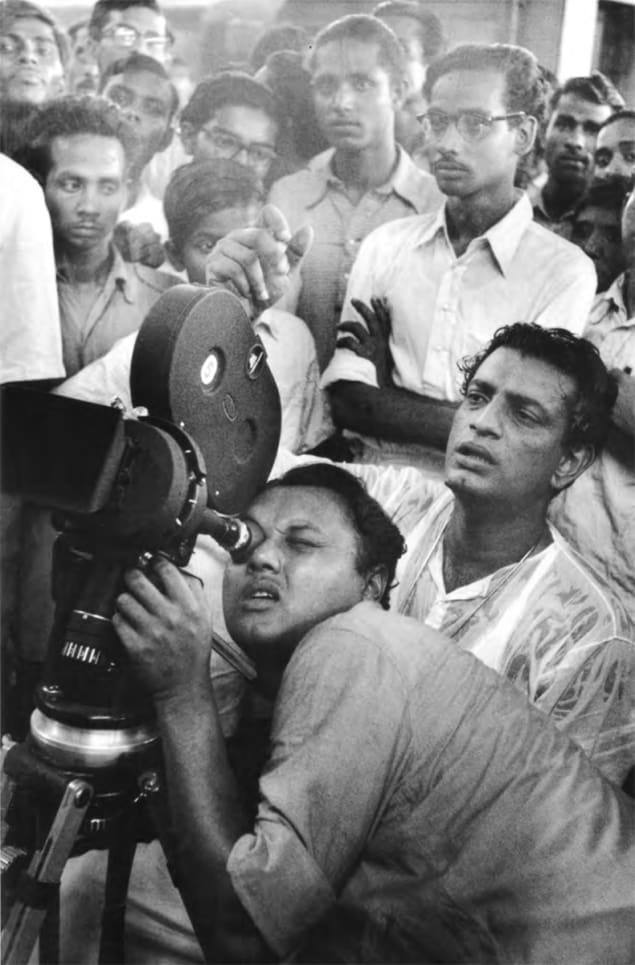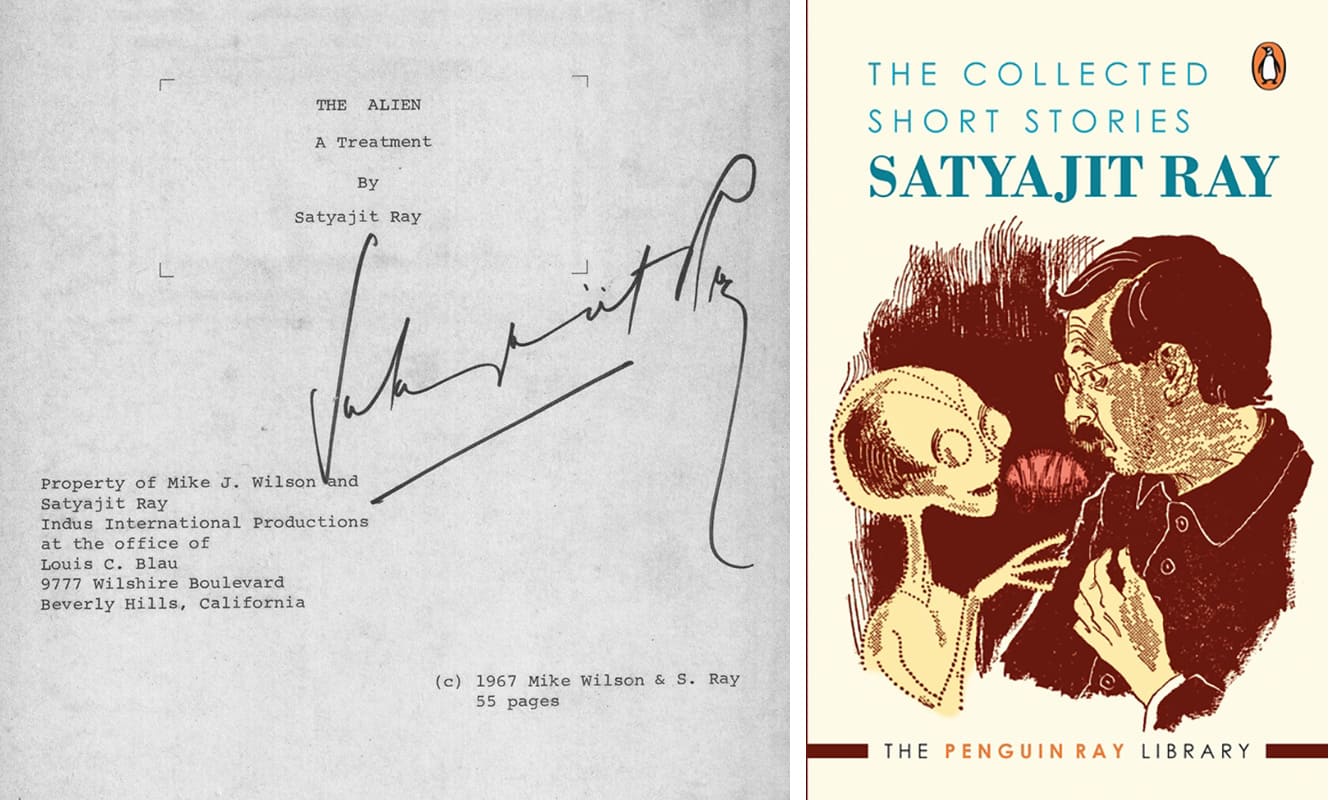Andrew Robinson delves into the life and work of the famed Bengali film director, who blended art and science, and uncovers the story behind his sci-fi film that didn’t make it to the screen, but nevertheless influenced Hollywood

Picture a scenic pond nestled within the confines of a small village in Bengal, its calm surface dotted with lotus flowers. Then imagine, one moonlit night, a spaceship splashing down and sinking into its depths, until the only thing visible is a golden spire sticking out of the water. The local villagers think it is a temple risen from the Earth below. Most of them decide to worship it. Little do they realize that the object contains a small humanoid creature that will invisibly play havoc in their lives.
If you think this sounds like an entertaining idea for a science-fiction film, you would be right. And if perhaps, you were to think it somewhat similar to the famous 1982 film E.T. the Extra-Terrestrial, directed by Steven Spielberg, you might not be far off either. But this other alien, the one that crash-landed in India and not America, never quite made it to movie screens across the globe, despite being dreamed up in the 1960s by one of the most significant film directors of the 20th century – Satyajit Ray.
Universal appeal
Born in Calcutta (Kolkata) in 1921, the Bengali polymath was not only a film director but also an established author, essayist, magazine editor, illustrator, calligrapher and music composer. Although all of his films are set in India, the finest of them hold worldwide appeal. Between 1955 and 1991, Ray directed almost 30 features, as well as short films and documentaries. Many won leading prizes at international film festivals. In 1991 he was awarded an Oscar for lifetime achievement – the only such Oscar to be bestowed on an Indian director. Ray also received an honorary doctorate from the University of Oxford: the second film director to be awarded this honour after his hero Charles Chaplin.
Not to have seen the cinema of Ray means existing in the world without seeing the Sun or the Moon
Akira Kurosawa
“Not to have seen the cinema of Ray means existing in the world without seeing the Sun or the Moon”, said Japan’s iconic film director, Akira Kurosawa, in 1975. On Ray’s 70th birthday in 1991, British film director Richard Attenborough, who had acted superbly on screen for Ray, called him a “rare genius”. And in 2021, on the centenary of Ray’s birth, American film director Martin Scorsese proclaimed that his films “are truly treasures of cinema, and everyone with an interest in film needs to see them”.

Ray’s many admirers include a number of luminaries from science, as well as the arts. Chief among them was science writer and novelist Arthur C Clarke, who described Ray’s debut film Pather Panchali (1955) – the first of his classic Apu Trilogy – as “one of the most heartbreakingly beautiful films ever made”. A founder of econophysics, Eugene Stanley, wrote of the “Bengali genius” Ray in a 1992 issue of the statistical mechanics journal Physica A (186 1) – remarking that the director’s recent death had “left the world immeasurably poorer”. And today, a leading Indian theoretical physicist, Dipankar Home, says that he is “amazed by the profundity and steadfastness of Ray’s commitment to a scientific outlook, permeating his varied creations”.
Prolific polymath
Focusing on Bengal but also depicting other parts of India, Ray’s films cover everything from village poverty to urban wealth; they stretch from the 19th-century British Raj to the present-day; and they include comedies, detective stories, musicals, romances and tragedies. Uniquely among great film directors (apart from Chaplin), Ray wrote the script, cast the actors, designed the costumes and sets, operated the camera, edited the film and composed its score, drawing on his passion for Indian and western music. But unlike Chaplin, Ray was not keen to act himself, despite interest from leading Hollywood producers, such as David Selznick. As Ray once explained to the admiring but slightly offended actor Marlon Brando, “No it’s better behind the camera… It would be too tedious, you see”!
In addition to film-making, Ray was a sought-after graphic designer and illustrator, and a bestselling writer of short stories and novels, aimed at both children and adults. His first job, from 1943 to 1956, was with a British advertising agency in Kolkata, and he continued writing fiction until his death. His books, which were later extensively translated from Bengali into English, include both detective stories and science fiction, partly inspired by his early reading of Arthur Conan Doyle, Jules Verne and H G Wells. The Bengali detective he created in his 1965 short story Feludar Goendagiri (English title Danger in Darjeeling) was influenced by his childhood love of Sherlock Holmes. Nicknamed Feluda, the character was also dramatized on screen by Ray as well as being the star of over 30 of his stories and novels. Indeed Feluda has become Ray’s most familiar creation in today’s India, especially with younger audiences.
Fascinated by science
Ray’s grandfather Upendrakisore and father Sukumar were notable writers and illustrators themselves, and both were trained in science (unlike Satyajit). Their stories, comic verse and drawings remain much loved in Bengal today, and their influence on Ray is clear from his many films that reveal the director’s lifelong fascination with science – covering everything from physics and astronomy to medicine and psychology. Perhaps the most famous scene in Pather Panchali shows the curiosity and awe induced in the uneducated village boy Apu by the sound of humming telegraph wires, immediately followed by the boy’s first sight of a passing steam train scattering black smoke across a field of white pampas grass. And in Ray’s last feature film, The Stranger (1991), an avuncular anthropologist enchants his schoolboy great-nephew in Kolkata with a puzzling question: why are the apparent sizes of the Sun and the Moon in the sky similar, and the Earth just the right size for total solar and lunar eclipses? When the boy has no answer, his great-uncle tells him: “I say it’s one of the greatest mysteries of the universe. The Sun and the Moon. The King of the Day, the Queen of the Night, and the shadow of Earth on the Moon … all exactly the same size. Magic!”

In 1983, in an Indian magazine interview, Ray explained his fascination with science, saying that “this universe, and its incessant music, may not be entirely accidental. Maybe there is a cosmic design somewhere which we don’t know”. Talking about the wonders of nature, he continued, “Watch the protective colourations of birds and insects. The grasshopper acquires the exact shade of green that helps it merge in its surroundings. The marine life and the shore birds put on the exact camouflage. Could it all be coincidence? I wonder. I don’t mystify it either. I think someday the human mind will explore all the mysteries of life and creation the way the mysteries of the atom have been explored.”
Visitor from other worlds
This attitude triggered Ray’s highly original science-fiction film project The Alien, which was taken up by Hollywood in 1967. It emerged in 1964 from a letter written by Ray to Clarke at his home in Sri Lanka, requesting his good wishes for a Kolkata science-fiction cine-club. Clarke replied expressing admiration for Ray’s films and a correspondence developed, which led to their talking in London after watching Clarke’s collaborator Stanley Kubrick – who revered Ray – directing 2001: A Space Odyssey. Ray outlined his idea for the project, and Clarke found it compelling enough to discuss it with another friend Mike Wilson – a flamboyant film-maker and professional skin-diver. Wilson, who was a keen sci-fi fan, volunteered to sell the project internationally.
As already mentioned, The Alien stars a small humanoid creature whose spaceship splashes down in a Bengali village pond where most (but not all) villagers take it to be a submerged temple and begin to worship it. The exceptions include Haba, a poor boy who survives off stolen fruit and begging and who forms a rapport with the alien creature after it has entered his dreams at night and played with him. Another doubter is Mohan, a sceptical journalist from Kolkata, who questions the existence of godly beings. There is also Joe Devlin, a “can-do” US engineer, who distrusts anything he has not personally experienced.
Devlin is in this backwoods area to drill tube-wells on behalf of a dubious Indian industrialist called Bajoria. On seeing the spire, Bajoria instantly perceives its possibilities as “the holiest place in India”. He offers Devlin money to pump out the pond, so its floor can be covered with marble and a marble structure built with a little plaque saying: “Salvaged and restored by Gaganlal Laxmikant Bajoria”!

The extra-terrestrial creature has other ideas though. Consumed with playful curiosity about the world in which it has just landed, it invisibly gets up to all sorts of very visible mischief: ripening a villager’s corn overnight; making a mango tree belonging to the meanest man in the village fruit at the wrong time of year; causing an old man’s corpse lying on its funeral pyre to open its eyes in front of his grandson; and other inexplicable pranks.
Ray drafted The Alien’s screenplay in Kolkata during early 1967, watched by Wilson, who made some useful suggestions, including the golden colour of the spaceship. Ray then proposed that British comedian Peter Sellers should fill the role of Bajoria well. He had admired Sellers in Kubrick’s Dr Strangelove and knew that Sellers had already played an Indian in The Millionairess. Soon, Ray and Sellers met in Paris over lunch arranged by Wilson, and Sellers apparently accepted the role enthusiastically.
The next stop on Ray’s Alien tour was Los Angeles, after he received a sensational cable from Wilson that Columbia Pictures wanted to back the film. There Ray was taken aback to discover mimeographed copies of his screenplay bearing the legend “copyright 1967 Mike Wilson & S Ray” circulating in Hollywood. He also met Sellers again, then filming another Indian role in The Party, but sensed the actor had developed doubts. After being whisked off by Wilson to a series of glamorous parties with film stars, Ray left Hollywood for Kolkata convinced that his innovative Indian project was “doomed”.
To its credit, Columbia remained committed, subject to Wilson’s withdrawal. Ray felt that Clarke was the only person who might bring this about. Clarke responded with a letter saying that Wilson had shaved his head and gone off to meditate in the jungles of south India as a monk. A brief letter from Wilson to Ray finally followed, relinquishing any rights to the Alien screenplay.
Striking similarities
For more than a decade Ray was encouraged by Columbia to revive the project and continued to treat it as possible. Not until he saw Spielberg’s E.T. did he give up hope. E.T., which began life in 1981 as a Columbia project, had much in common with Ray’s concept of The Alien. First, there is the benign nature of the creature. Then, as Ray told me in the mid-1980s while I was researching his biography, there is the fact that it is “small and acceptable to children, and possessed of certain superhuman powers – not physical strength but other kinds of powers, particular types of vision, and that it takes an interest in earthly things”.
Ray felt, though, that the appearance of his alien was much more interesting. “Mine didn’t have any eyes,” he continued. “It had sockets so the human resemblance was already destroyed to some extent. And mine was almost weightless and the gait was different. Not a heavy-footed gait but more like a hopping gait. And it had a sense of humour, a sense of fun, a mischievous quality. I think mine was a whimsy.” Ray could understand the audience appeal of Spielberg’s alien, though he found E.T. “a bit corny at times”. But he did not care for the extent to which the alien had been humanized. “It ought to be more subtle than that,” he said. “But the children are marvellous. Spielberg has talent in handling children; I’m not sure about otherwise.”
Turning science to movie magic
The first outsider to spot the similarities was Clarke, who described them as “striking parallels”. Telephoning Kolkata from Sri Lanka in 1983, he suggested Ray write politely to Spielberg about the resemblances. “Don’t take it lying down,” advised Clarke, according to Ray. But despite the fact that Ray remained firmly of the view that E.T. “would not have been possible without my script of The Alien being available throughout America in mimeographed copies”, he did not want to pursue the matter further. Ray agreed with Clarke that “artists have better things to do with their time”; and he knew that Spielberg’s view, according to a letter Clarke wrote to the Times newspaper in 1984, was that he was too young to have been influenced by Ray’s screenplay.
“Tell Satyajit I was a kid in high school when his script was circulating in Hollywood,” Spielberg told his friend Clarke on a visit to Sri Lanka “rather indignantly” – which hardly resolves the doubts, especially as Spielberg in the late 1960s was already an adult getting started in movies. According to Clarke, Ray and Spielberg were “two of the greatest geniuses the movies have ever produced”. However, as Scorsese publicly remarked in 2010, “I have no qualms in admitting that Spielberg’s E.T. was influenced by Ray’s Alien. Even Sir Richard Attenborough pointed this out to me.”
Naturally, Ray regretted that his film never got made. His only consolation was that the screenplay’s delicate effects might well have been crushed by crass Hollywood production values, especially since the story was located in India. One can easily imagine the fate of Ray’s Bengali “whimsy” in Hollywood hands. Perhaps it was for the best that Ray’s project evanesced like the alien spaceship’s lift-off from the pond in the finale of the screenplay – before the Bajorias of Beverly Hills could pump out the water and get a commercial grip on it.



